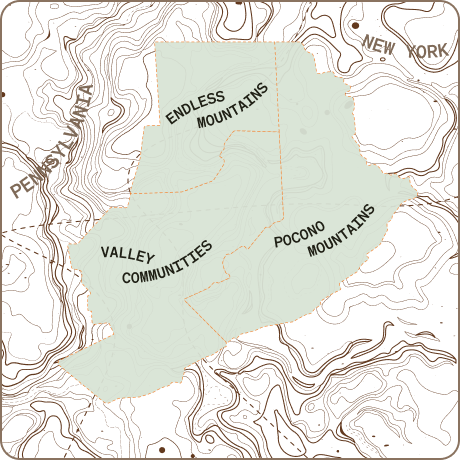Quiet suburbs, picturesque riverside communities and lively downtowns make up these fourteen charming communities situated on the banks of the Susquehanna River between Wilkes-Barre and Scranton.
Discover Pittston’s beautiful wall murals, modern art sculptures and creative arts scene during Pittston City Second Friday Art Walk.
While downtown, have a drink at Rooftop 53 and enjoy fine dining at Rikasa or upscale Italian cuisine at Pazzo 315. Meet local farmers and artisans at the Pittston City Farmers’ Market.
Start your day with a fresh brew at Drip Coffee Company and explore pristine forests, meadows, lake and wetlands at Frances Slocum State Park.
After a day of golf at Fox Hill County Club, enjoy NEPA’s favorite food at Sabatini’s Pizza and a cold craft beer at Susquehanna Brewing Co.
For a dose of nostalgia, stop by Ballyhoo Ice Cream and Candy before checking out a film at Moonlite Drive-In.

Known for:
Susquehanna River
Susquehanna Brewing Co.
Incredible, locally-owned restaurants
Hip art scene
By the Numbers:
Geographical Area: 65 Sq. Miles
Estimated Population: 46,460
School Districts: 2
Regional makeup: The city of Pittston; the townships of Exeter, Jenkins, Pittston, and West Pittston; and the boroughs of Avoca, Dupont, Duryea, Exeter, Hughestown, Laflin, West Wyoming, Wyoming, and Yatesville.
Popular Things to Do
See All



















Writer

Small town Main Street feel combines with artsy metropolitan vibes in one of NEPA’s evolving cities.
Learn More
A vibrant community centrally located along the Susquehanna River between Wilkes-Barre and Scranton.
Learn More
Jenkins Township, PA is a quiet township with a big economic footprint.
Learn More
Writer

Writer
A Peak Into Greater Pittston Past
Pittston City’s land was first surveyed by the Susquehanna Land Company of Connecticut in 1768 and claimed as part of Connecticut. It was originally called “Pittstown” in honor of the famous British statesman William Pitt the Elder.
With the first discovery of anthracite coal in the Wyoming Valley around 1770, the first mine was established in 1775 near Pittston. Just a few years later, it played a key role in the Revolutionary War during the 1778 Battle of Wyoming between Patriot militia, Loyalist soldiers and Iroquois warriors in the present-day borough of Wyoming.
Did you know?
Pittston was given the title of “Quality Tomato Capital of the World” in the 1930s for fulfilling the high demand for tomatoes to metropolitan New York thanks to the North Branch Canal. The fertile, river-fed soil high in pH due to anthracite in Northeastern Pennsylvania is prime for growing and producing especially flavorful tomatoes.




















































